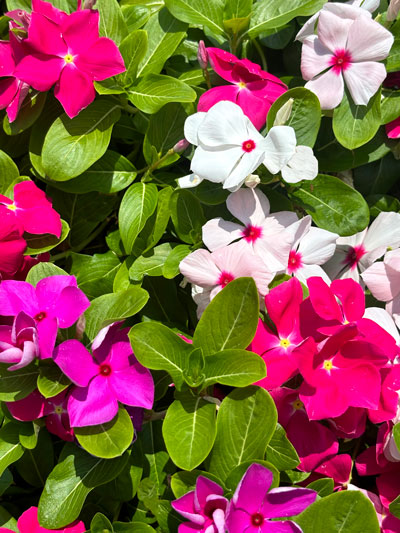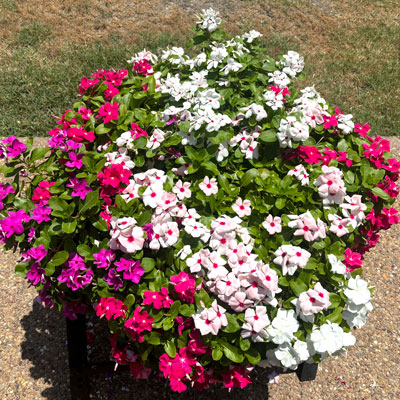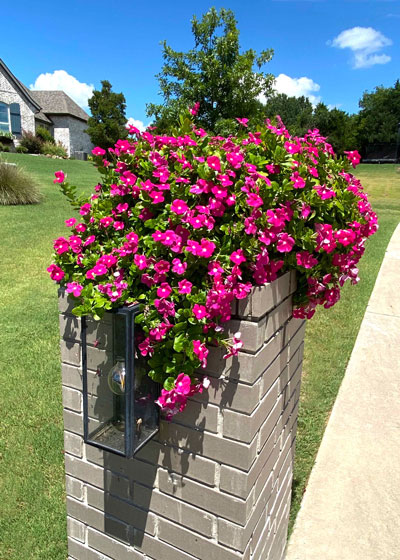Cora Cascade Trailing Vincas Perform
(Photo credits to my friend Kenneth Cranfill, retired greenhouse operator who produced tens of thousands of flats of vincas and other fabulous annuals for North Texas gardeners in his decades-long career. He’s now moving furniture daily for his church charity. Happy retirement, Kenneth!)

If you’ve gardened in Texas very long you’ve probably grown vincas – periwinkles.
If you’ve gardened in Texas for a very long time, you remember when we only had three colors: white, rosy-red, and pink, some with “eyes” and some without. And you remember how we let them reseed themselves. Once you had periwinkles, you always had periwinkles.
Then a disease moved in. Aerial Phytophthora. (I’ll still give you credit if you don’t remember that name.) That’s the disease that wiped out vinca plantings all across the South for maybe 25 years. Plants’ stems withered and plantings died. The disease was spread by splashing water, but it was almost impossible to avoid that splashing water when we had to irrigate our plants to keep them growing. (Want to see what Aerial Phytophthora looks like? The photo that accompanies the first question in this week’s Q&A shows it at the top of the photo – vincas are above the mums in the photo.)
Then improvements came along from the plant breeders, and we thought we had disease resistance built into the new types. But the disease soon came back.
The breeders kept working, and now we have Cora XDR Vincas, standing for “Extreme disease resistance.” And this one has been thoroughly tested and has held strong for many years. At this point the “XDR” improvement applies only to standard upright Coras, not to the trailing types that are (more or less) the subject of our story today. But the water mold fungus is seldom a problem with the Cora Cascades since we generally use them in pots, baskets and wall planters where drainage and air movement are excellent.

The best is even better…
Now Cora Vincas are available in trailing strains suitable for patio pots, even wall pots, plant stands and hanging baskets. These are real game changers.
These are hybrid plants for predictable and uniform color, growth habit, and durability. They bloom from the first days of hot summer weather all the way into late fall. They cover themselves with big, beautiful vinca blooms, and the breeder keeps adding colors. Kenneth warns me that the Cora Cascade series is not commonly sold in many nurseries, even in prime selling season of late spring. Ask ahead if your favorite nursery will have them next spring. (Create a little demand.) Here is the current list from the Syngenta (grower) website:
• Cora Cascade Apricot Improved
• Cora Cascade Bright Rose
• Cora Cascade Cherry
• Cora Cascade Lavender with Eye
• Cora Cascade Lilac
• Cora Cascade Polka Dot (white with red eye)
• Cora Cascade Shell Pink
• Cora Cascade Strawberry
• Cora Cascade Violet
• Cora Cascade White Improved
• Cora Cascade Mixed.

Simple tips…
Once you locate your source, plant your Cora XDR or Cora Cascade Vincas in loose, highly organic potting soil. Be sure they will receive perfect drainage but make provision that they will be moist at all times.
Your Cora Cascade plants will grow to be 6 to 8 inches tall and 24 to 30 inches wide. They require full or nearly full sun.
Feed with a diluted water-soluble, complete and balanced fertilizer every couple of times that you water them. Keep water off the leaves and stems as best you can. In other words, avoid overhead irrigation whenever possible.
The plants will be “self-cleaning,” meaning that their spent flowers will shrivel and dry up. You will have very little litter to sweep up.
